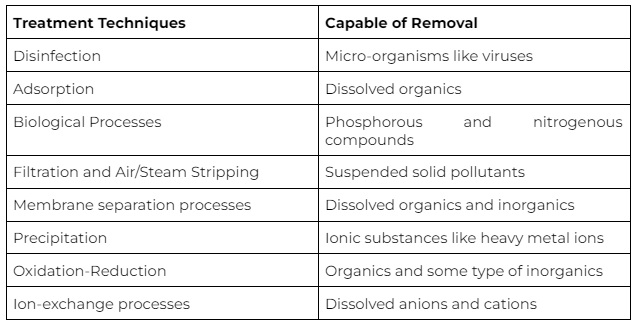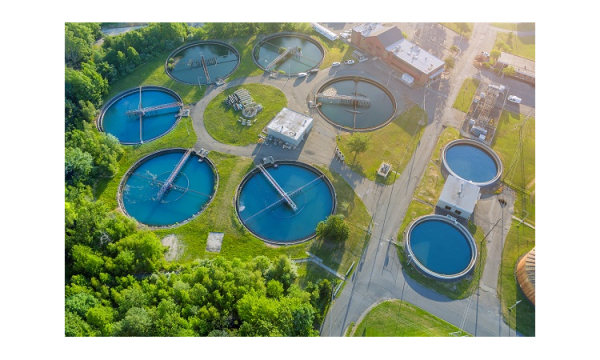Besides the wastewater itself, the percentage of harmful substances is also increasing, which makes the cleaning process more complex and constantly challenges wastewater treatment plant (WWTP) professionals and operators. To provide you a better understanding in this topic, in the following article, we give an insight into the following: What methods are used to treat wastewater? What does tertiary treatment mean and why is it important? How to successfully and effectively design Tertiary Treatment in a WWTP? Let’s start with the basics.
What is Tertiary Treatment in a WWTP?
Before delving into the specifics of tertiary treatment procedures, let’s quickly go through the primary and secondary wastewater treatment:
Primary wastewater treatment entails filtering out large solid pollutants: the wastewater is temporarily held in a tank where heavier materials sink to the bottom while smaller and lighter solids get to the surface. Once the larger solids are settled, it's easier to hold them back while the liquid is moved through to the more rigorous secondary wastewater treatment.
Secondary wastewater treatment operates at a deeper level than primary treatment and is intended to significantly degrade the biological component of the waste through aerobic biological processes. This treatment provides for safer discharge into the local environment by lowering typical biodegradable pollutants to acceptable levels.
It is accomplished in one of three ways:
- Biofiltration
- Aeration
- Oxidation ponds
The tertiary treatment process is the final step in the wastewater cleaning process. It removes various harmful substances from the water, such as viruses, bacteria, and parasites. It makes the water safe to release to nature and reuse.
Why is it important?
The goal of tertiary wastewater treatment is to improve water quality to satisfy both industrial and domestic standards, or to fulfill particular criteria for safe water disposal. In the case of municipally treated water, the tertiary treatment also includes pathogen elimination, ensuring that the water is safe to consume.
Tertiary Wastewater Treatment Methods
Once proper primary and secondary treatment is completed, suspended particles and dissolved organics, such as recalcitrant biodegradables, unreacted biodegradables, non-biodegradable organics, odoriferous and coloring matter, dissolved inorganics, and microorganisms including pathogens may still be present in wastewater. The processes used to reduce these pollutants are called tertiary treatment methods. The treatment techniques to be utilized and their sequencing depends on the concentration of the pollutants in a wastewater stream and whether the treated effluent will be reused or disposed of.

Filtration
Filtration is frequently used as part of a tertiary treatment system to remove very tiny suspended particles from a wastewater stream. The bulk of suspended particles is removed by sedimentation as part of the main treatment and following secondary treatment. Although sedimentation is capable of eliminating tiny solid particles, extremely fine particles may remain suspended. Such particles must be removed from wastewater before further procedures can be used to treat the water. Generally, a stream is filtered to remove suspended particles following sedimentation.
Stripping using air or steam
Stripping is also known as desorption. If the pollutant concentration is rather high, wastewater steam stripping might be used during tertiary treatment. Another condition for selecting the stripping process is that the contaminants present be very volatile, for example have a low boiling point.
Biological processes in tertiary treatment
Organics that remain in a wastewater stream after the secondary treatment are usually non-biodegradables and recalcitrant biodegradables. Besides, organic nitrogenous and phosphorous compounds may be present too. These harmful molecules in wastewater can be reduced using biological methods during the tertiary treatment.
Adsorption
Activated carbon, which can be powdered or granular, is the most often utilized adsorbent for tertiary wastewater treatment. When wastewater is processed using activated carbon particles, organic molecules in the wastewater may become adsorbed on the particles' outer and pore surfaces.
Disinfection
Once inorganic and organic contaminants are removed from a wastewater stream, it is released either into a land or a water body. If it is chosen to be released to a treated wastewater stream, it must be disinfected as a part of the WWTP tertiary treatment. It means that any microorganisms present, such as pathogens, viruses, or protozoa, must be erased or inactivated. If not adequately cleaned, discharged water can damage living beings who come into touch with it.
How to design tertiary treatment in a WWTP?
Thanks to technological developments, plenty of innovative systems are available to make WWTPs designing much easier, faster and more efficient, including tertiary treatments. Some of the most advanced online water facility design engineering platforms allow experts to quickly develop preliminary plans for CAS facilities as well as MBR, MBBR, and other types of facilities. Using such a software to design a WWTP comes with multiple benefits. It helps the users to save money, increase speed, improve decision making and get regular updates which are essential for successful planning and future operation of wastewater treatment plants.










